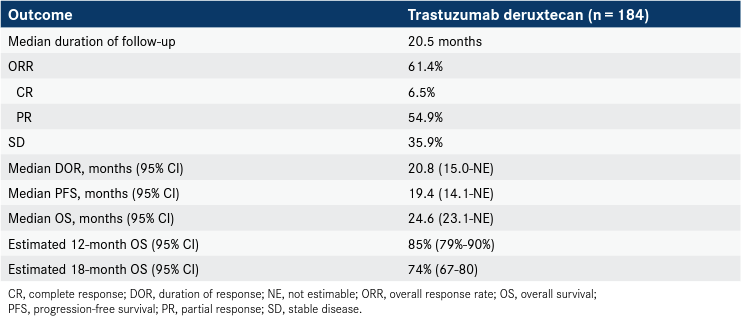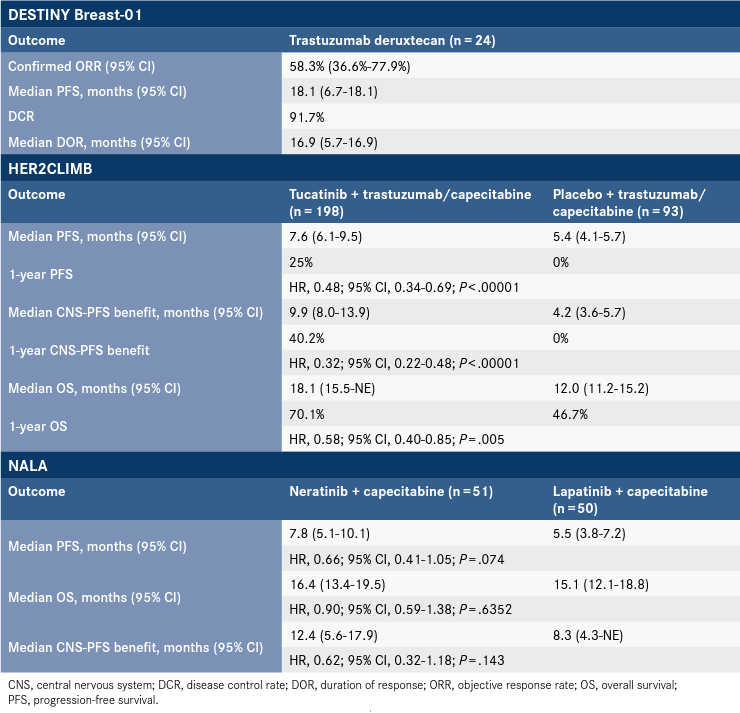Future Is Wide Open for HER2+ Breast Cancer
As longer-term follow-up data become available for several agents approved for HER2-positive metastatic breast cancer, investigators are looking closely at the characteristics of patients enrolled in those clinical trials to determine appropriate treatment strategies in the third-line setting and beyond.
William J. Gradishar, MD

As longer-term follow-up data become available for several agents approved for HER2-positive metastatic breast cancer, investigators are looking closely at the characteristics of patients enrolled in those clinical trials to determine appropriate treatment strategies in the third-line setting and beyond. The treatment landscape most recently expanded in the past 2 years to include fam-trastuzumab deruxtecan-nxki (Enhertu), margetuximab-cmkb (Margenza), tucatinib (Tukysa), and a new indication for neratinib (Nerlynx).
“With any drug that’s new and particularly when it’s approved in the metastatic later lines, the goal is to move it up,” said moderator William J. Gradishar, MD, during a recent OncLive® Breast Cancer Talk. “From a business standpoint, you want to get into the pool where the greatest number of patients are.” Without data from head-to-head trials, baseline characteristics such as mean number of prior therapies as well as central nervous system (CNS) metastases are proving to be guideposts for sequencing therapies following treatment with ado- trastuzumab emtansine (Kadcyla; T-DM1) in the second line.
Gradishar was joined by Priyanka Sharma, MD, and Pavani Chalasani, MD, MPH, to discuss recent data from several trials of anti-HER2 treatment options and how they approach sequencing the agents in the clinic based on the results of 3 pivotal trials:
- DESTINY-Breast01 (NCT03248492), which is assessing trastuzumab deruxtecan in patients with unresectable or metastatic HER2-positive breast cancer who have received 2 or more prior anti-HER2–based regimens in the metastatic setting,1,2
- HER2CLIMB (NCT02614794), which is evaluating tucatinib in combination with trastuzumab (Herceptin) and capecitabinefor patients with advanced unresectable or metastatic HER2-positive breast cancer who have received 1 or more prior anti-HER2–based regimens in the metastatic setting3 and,
- NALA (NCT01808573), which is assessing neratinib plus capecitabine in patients with metastatic HER2-positive breast cancer who received 2 or more prior anti-HER2–based regimens in the metastatic setting.4
Gradishar: The year 2020 really demonstrated that we’ve continued to make progress in the HER2-positive space. A variety of drugs have been evaluated with several receiving approval. We’ve heard a sequence of updates from the 2020 American Society of Clinical Oncology [ASCO] Virtual Scientific Program, the European Society for Medical Oncology Congress [ESMO] Virtual Congress, and now the virtual San Antonio Breast Cancer Symposium that looked at these different agents in different settings.
The agents that [received] the most attention by far are trastuzumab deruxtecan, tucatinib, and then, of course, neratinib, which had been around for a while [and was], somewhat surprisingly, first approved in the adjuvant setting and only recently approved in the metastatic disease setting. To start us out, Dr Sharma, if you would be willing to give us an overview of the DESTINY-Breast01 trial with trastuzumab deruxtecan.
Sharma: Sure. We’re all familiar with DESTINY-Breast01. It’s a phase 2 single-arm study but the data were so convincing and effective, [that they] led to approval of trastuzumab deruxtecan [in December 2019]. Patients with pretreated HER2-positive metastatic breast cancer received trastuzumab deruxtecan at various dose levels. The dose level that’s currently approved [5.4 mg/kg intravenously every 3 weeks] is the cohort [from which] investigators are presenting follow-up data.
Priyanka Sharma, MD

This is an additional follow-up from what we saw published in New England Journal of Medicine in February 2020. What we see is the durability of responses holding with additional follow-up. The median duration of response was 20 months, which is quite robust. We haven’t seen this kind of durability [with] other studies before. At 18 months, more than 70% of patients were still alive; that’s an indication for overall survival [Table 11].
Table 1. Updated Efficacy Data DESTINY-Breast011

This is a heavily pretreated patient population, and in spite of prior treatment—including most patients who had received an antibody-drug conjugate, mainly T-DM1—we are seeing special robustness of response. It’s good to see that and it was reassuring to see this follow-up.
Another aspect that the investigators elaborated on was interstitial lung disease [ILD], which we all are concerned about as we prescribe this drug to our patients because of the incidence and the mortality, [the] small proportion of patients who have died from this adverse effect.
The investigators showed that after a year of therapy, the incidence of ILD went down—there was only 1 patient who developed ILD after 1 year of therapy. That’s also an import-ant piece of information because as we start prescribing this agent to our patients, many have stayed on [it] for a while and we can stop worrying about ILD too much after a year.
Of course, we still need to be paying attention [for incidence of] it, as we do our scans and warn our patients of signs and symptoms. I was impressed to see this follow-up from DESTINY-01 and obviously we’re all awaiting the results of the randomized trials, comparing this agent with others.
Gradishar: Tucatinib has gotten all the press about the CNS benefit and we’ll come to that in a moment. But with respect to trastuzumab deruxtecan, there’s a little bit of a data set, 24 patients or [so] who had brain metastases at the time they were in the trial. Can you comment on that?
Sharma: That was a subset analysis that was presented at ESMO this year for a small number of patients. The investigators reported that the median progression-free survival was approximately 18 months in that small subset, which is not too far off from the median progression-free survival in the overall study population. In that report, 1 patient with CNS disease responded with the drug.
Of course, it’s a much smaller data set of patients with CNS metastases as compared with what we saw in HER2CLIMB. But it’s reassuring to see that, and I’m sure in the forthcoming trials, the subgroup [will] be larger, and we will see more data on it [Table 22-4].
Table 2. Updated Data for Patients With CNS Metastases2-4

Gradishar: Great, so with that said, let’s move on to the HER2CLIMB trial. Dr Chalasani, can you give us an overview of that trial as well as the brain metastases data?
Chalasani: Yes, the HER2CLIMB study, as we all know, was published in the New England Journal of Medicine, and was presented at San Antonio in 2019, [which were] the data that actually got the drug approved. It is a large, randomized phase 3 trial looking at tucatinib in combination with capecitabine and trastuzumab versus capecitabine and trastuzumab alone. The data showed meaningful and statistically significant improvements in both overall survival and progression-free survival in patients.
Nancy U. Lin, MD, presented an update on the data for patients with brain metastases at ASCO. Approximately 48% of patients enrolled on the study had brain metastases. The data Lin presented at that time showed patients in the tucatinib arm had a 68% reduction in CNS [progression] compared with the arm [without tucatinib], supporting the efficacy of this drug in patients who also have CNS metastases [Table 22-4].
The presentation concluded that even for patients with previously treated HER2positive metastatic breast cancer with brain metastases, tucatinib with a combination of trastuzumab and capecitabine doubled overall response rate intracranially and reduced the risk of progression in brain metastases. Further, overall survival was improved. These data have definitely changed the standard of care for patients who have HER2-positive disease with brain metastases.
Gradishar: In a typical sequence, based on what we know today, a CLEOPATRA–like regimen [docetaxel and trastuzumab plus pertuzumab (Perjeta)] for most patients starts us off, followed by T-DM1. And then, we now have these additional drugs. How would you think about sequencing or [for which] patients would you utilize one vs the other after T-DM1?
Sharma: If a patient has a history of brain metastasis, I have a discussion with them. The tucatinib combination does require several oral drugs, so the [adherence] for all of those has to be considered. The mean lines of prior therapy for trastuzumab deruxtecan was 6, so I feel I can situate it later and still get the benefit because most patients in that study had had several lines of treatment. Whereas for HER2CLIMB, the median was approximately 2 or 3. I [approach] the third-line setting to stay within the parameters of the patient population presented in the trial.
Chalasani: I take a similar approach. If the patient has brain metastases, then I lean toward tucatinib early. The HER2CLIMB regimen with tucatinib does not get patients off intravenous treatment.
The quality-of-life data for the patients with brain metastases from HER2CLIMB presented at San Antonio this year actually showed that the combination arm with the tucatinib did not have any worsened quality of life and [that] patients did pretty [well].
Gradishar: I take a similar approach. If the patient has brain metastases, then I lean toward tucatinib early. The HER2CLIMB regimen with tucatinib does not get patients off intravenous treatment. The quality-of-life data for the patients with brain metastases from HER2CLIMB presented at San Antonio this year actually showed that the combination arm with the tucatinib did not have any worsened quality of life and [that] patients did pretty [well].
Pavani Chalasani, MD, MPH

Chalasani: [Investigators presented] an update at San Antonio of neratinib in combination with capecitabine in HER2-positive metastatic patients with CNS disease at baseline [Table 22-4]. The NALA study was a phase 3 study with a combination of neratinib and capecitabine vs lapatinib [Tykerb] and capecitabine. Data showed improvement in progression-free survival.
The updated data included CNS outcomes and [data showing that] the combination of neratinib and capecitabine was superior to lapatinib and capecitabine in progression-free survival. One interesting thing was the trial had patients with stable leptomeningeal disease. Two of the patients with leptomeningeal disease received the combination of neratinib and capecitabine and they were on the drugs for approximately 6 months and close to 10 months, respectively.
The overall survival for those 2 patients was close to 1.5 years, which is impressive knowing that those patients have a significantly worse prognosis because of leptomeningeal disease.
Gradishar: [There are additional trials we don’t have any data from yet including] trastuzumab deruxtecan going head-to-head with T-DM1, and we have trials that are looking at the addition of tucatinib plus T-DM1 vs T-DM1 alone.
Nevertheless, it will be interesting to see if the results change the sequence earlier on. [Also interesting are] the data for trastuzumab deruxtecan for the treatment of patients with low HER2 expression. In a sense, that potentially opens up another silo of patients with breast cancer and how we think about them. These are patients with 1+ or very low levels of HER2 expression.
We typically don’t think of utilizing HER2targeted therapy and instead lean toward chemotherapy if the patient is not ER [estrogen receptor]-positive. But there were data that were published showing that there is activity with trastuzumab deruxtecan in low-expressing HER2-positive tumors. We now have a formal trial looking at that, DESTINY-Breast04 [NCT03734029]. No data [are available] from that yet but that trial will compare physician’s choice chemotherapy vs trastuzumab deruxtecan.
If we find that is a positive trial, it may indeed offer us yet another option for these patients where we wouldn’t have thought of any sort of HER2-directed therapy.
References
- Modi S, Saura C, Yamashita T, et al. Updated results from DESTINY-breast01, a phase 2 trial of trastuzumab deruxtecan (T-DXd) in HER2 positive metastatic breast cancer. Cancer Res. 2021;81(suppl 4). doi:10.1158/1538-7445.SABCS20-PD3-06
- Jerusalem G, Park YH, Yamashita T, et al. CNS metastases in HER2-positive metastatic breast cancer treated with trastuzumab deruxtecan: DESTINY-Breast01 subgroup analyses. Ann Oncol. 2020;31(suppl 2):S63-S64. doi:10.1016/j.annonc.2020.03.239
- Lin NU, Murthy RK, Anders CK, et al. Tucatinib versus placebo added to trastuzumab and capecitabine for patients with previously treated HER2+ metastatic breast cancer with brain metastases (HER2CLIMB). J Clin Oncol. 2020;38(suppl 15):1005. doi:10.1200/JCO.2020.38.15_suppl.1005
- Saura C, Ryvo L, Hurvitz S, et al. Impact of neratinib plus capecitabine on outcomes in HER2-positive metastatic breast cancer patients with central nervous system disease at baseline: findings from the phase 3 NALA trial. Cancer Res. 2021;81(suppl 4). doi:10.1158/1538-7445.SABCS20-PD13-09



